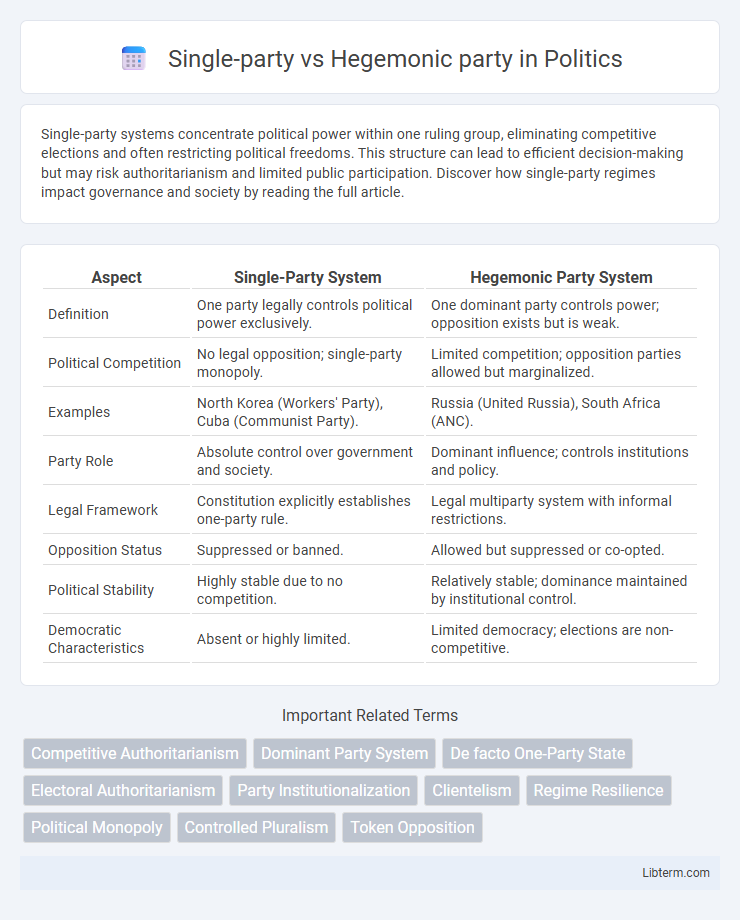Single-party systems concentrate political power within one ruling group, eliminating competitive elections and often restricting political freedoms. This structure can lead to efficient decision-making but may risk authoritarianism and limited public participation. Discover how single-party regimes impact governance and society by reading the full article.
Table of Comparison
| Aspect | Single-Party System | Hegemonic Party System |
|---|---|---|
| Definition | One party legally controls political power exclusively. | One dominant party controls power; opposition exists but is weak. |
| Political Competition | No legal opposition; single-party monopoly. | Limited competition; opposition parties allowed but marginalized. |
| Examples | North Korea (Workers' Party), Cuba (Communist Party). | Russia (United Russia), South Africa (ANC). |
| Party Role | Absolute control over government and society. | Dominant influence; controls institutions and policy. |
| Legal Framework | Constitution explicitly establishes one-party rule. | Legal multiparty system with informal restrictions. |
| Opposition Status | Suppressed or banned. | Allowed but suppressed or co-opted. |
| Political Stability | Highly stable due to no competition. | Relatively stable; dominance maintained by institutional control. |
| Democratic Characteristics | Absent or highly limited. | Limited democracy; elections are non-competitive. |
Introduction to Party Systems
Single-party systems are political frameworks where one party dominates governance, eliminating opposition and centralizing power. Hegemonic party systems allow the existence of multiple parties but maintain a dominant party that consistently controls political power through institutional advantages and limited competition. Both systems contrast with multi-party democracies, influencing political stability, governance, and citizen participation within various regimes.
Defining Single-Party Systems
Single-party systems are political structures where one party holds exclusive power, prohibiting opposition parties from participating in governance, often codified in the constitution or legal framework. Hegemonic party systems allow for nominal opposition parties but maintain dominance through control of electoral processes, media, and state resources, ensuring consistent victories for the ruling party. The defining characteristic of single-party systems lies in the legal and institutional monopoly on political power, contrasting with hegemonic systems that sustain dominance through political manipulation rather than outright prohibition of competition.
Understanding Hegemonic Party Systems
Hegemonic party systems feature a dominant political party that maintains power for extended periods while allowing limited competition from opposition parties, unlike single-party systems that prohibit opposition entirely. In hegemonic systems, the ruling party controls key state resources and institutions, ensuring electoral advantages and influence over policymaking. Understanding the mechanisms of electoral manipulation, patronage networks, and media control is essential to grasp how hegemonic parties sustain long-term dominance without outright banning rival parties.
Historical Contexts and Emergence
Single-party systems originated primarily in post-colonial states where newly independent nations sought centralized control to foster national unity and development. Hegemonic party systems emerged in contexts where dominant parties allowed limited political competition, maintaining control through institutional advantages and co-optation rather than outright bans. Historical examples include the African National Congress in South Africa's transitional era as a hegemonic party, contrasting with single-party rule under the Communist Party in China following revolution.
Structural Differences Between the Two
Single-party systems centralize all political power within one dominant organization, controlling governance and policy-making without competition or opposition. Hegemonic party systems feature a dominant party that maintains control through a pluralistic political environment, allowing limited competition but systematically marginalizing rivals. Structurally, single-party regimes enforce strict party membership and discipline, while hegemonic parties function within formal democratic frameworks, leveraging state resources and media to sustain dominance.
Political Participation and Opposition
Single-party systems restrict political participation to members of the ruling party, effectively eliminating genuine opposition and fostering a controlled political environment. Hegemonic party systems allow multiple parties and limited competition, but dominate political participation through institutional advantages and co-optation, marginalizing opposition parties. Opposition in hegemonic systems exists but faces significant barriers such as legal restrictions, media bias, and electoral manipulation, preventing effective challenges to the ruling party's dominance.
Governance and Policy Implementation
Single-party systems centralize power within one established political organization, streamlining governance and enabling swift policy implementation without opposition interference. Hegemonic party systems, while dominated by a leading party, allow minor parties limited participation, resulting in more complex governance dynamics and potential delays in policy enactment. Both systems emphasize control, but single-party regimes often achieve more uniform policy enforcement due to the absence of formal political competition.
Impacts on Civil Liberties and Democracy
Single-party systems typically restrict civil liberties by consolidating political power within one organization, limiting political pluralism and suppressing dissent, which weakens democratic processes. Hegemonic party systems, while allowing nominal multiparty competition, maintain dominance through institutional advantages and electoral manipulation, leading to diminished political competition and constrained civil freedoms. Both systems undermine democracy by restricting genuine political participation and reducing accountability mechanisms essential for protecting civil liberties.
Case Studies: Major Examples Worldwide
Single-party systems such as China, where the Communist Party dominates all political aspects, contrast with hegemonic party systems like South Africa's African National Congress, which maintains control through electoral competition but without significant opposition success. In single-party states, political pluralism is absent, exemplified by North Korea's Workers' Party, ensuring total control, whereas hegemonic parties allow limited political contestation, as seen in Mexico under the Institutional Revolutionary Party before democratic reforms. These case studies highlight how single-party regimes enforce strict centralized power, while hegemonic systems sustain dominance through a mixture of patronage, electoral advantage, and institutional control.
Conclusion: Key Takeaways and Future Trends
Single-party and hegemonic party systems both centralize power but differ in political openness and competition scope. Single-party systems typically exhibit rigid control over governance with limited or no opposition, while hegemonic party systems allow nominal multiparty participation under dominant party influence. Future trends suggest gradual shifts toward increased political pluralism in hegemonic regimes, driven by social demands and international pressures for democratization.
Single-party Infographic

 libterm.com
libterm.com